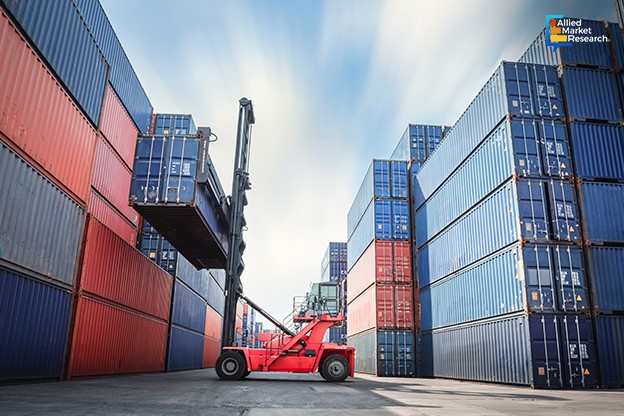Why Should Port Management Businesses Invest in Container Handling Equipment in 2024?

27 Feb
2024
Highlights:
- Introduction
- Evolution of container-handling machinery and its types
- The growth of the industry in North America
- Innovative product launches in the industry
Ports are the most important infrastructure from the perspective of a country’s trade. Naturally, most of the cargo, including imports and exports, is handled by container ships. Container handling equipment, which helps in the loading and unloading of goods, thus becomes extremely important for the smooth functioning of global trade.
Understanding the evolution of different container handling equipment
Before the standardization of container ships, handling of cargo was done through labor-intensive processes. However, after the standardization of containers as envisaged by Malcolm McLean, container-handling machinery gained prominence. Modern container-handling machinery is mainly concerned with the locking of cargo onto ships with the help of twist locks and spreaders. One of the most widely used types of container-handling machinery is the ship-to-shore (STS) crane. These cranes are primarily used for loading and unloading cargo on ships. While small STS cranes transport a single container in one go, modern mechanical engineering has made it possible to develop cranes that transport two to four ships at once. To facilitate their smooth functioning, these cranes are mounted on a rail system which allows their movement along the entire quay.
Along with STS cranes, mobile harbor cranes have also become quite a popular type of container-handling machinery. These cranes, as their name suggests, are designed to handle variable loading. They are mainly known for their versatility and flexibility as they can handle different types of cargo with ease. Ranging from bulk materials to steel scrap, these cranes are perfect for handling heavy loads, and due to their efficiency, they reduce operational costs significantly.
Apart from cranes, stackers also play a major role in handling containers and ensuring a smooth flow of trade. Stackers, also called container stacking vehicles, are used for loading cargo containers on top of each other. Reach stackers are generally used on small or medium-sized ports as they can cover short distances quickly. To manage the cargo traffic efficiently, many ports employ empty stackers, i.e., stackers who arrange and manage empty containers separately.
How is automation in container handling equipment helping the industry’s rise in North America?
In the post-globalization era, the volume of global trade has multiplied exponentially. Naturally, the scope of the container handling equipment industry has expanded too. This is especially true for the North American region which is expected to witness the growth of the industry at a CAGR of 6.1% from 2023-2032. The increasing shift towards automation has played a huge role in the growth of the industry in this region. Firstly, the North American region has a huge coastline with major ports on either side of the continent. These ports handle huge volumes of global trade with hundreds of container ships entering the dockyards each day. Naturally, manual handling of the operations in these ports is an extremely difficult task. Hence, the use of automated container handling equipment such as automated stacking cranes (ASCs) has become prevalent in these ports. Furthermore, the infrastructure necessary for upgrading these ports with automation technologies is also available in this region. The governments in this province are also allocating huge funds for the establishment of new automated systems in these harbors. All these factors have helped the growth of the industry in the North American region.
How are private players strengthening the position of the industry across the globe?
Apart from governmental support, private players in the shipping sector are also contributing to the growth of the container handling equipment industry. These companies are investing heavily in developing new technologies; some have even launched their products in the industry. For instance, in March 2023, Konecranes, a leading overhead crane manufacturer, announced the launch of the SMV 128 TC6 reach stacker which can handle a load of up to 12 tons. This product launch will expand the product portfolio of Konecranes and is expected to help the company increase its foothold in the industry in the coming period.
To wind up, the increasing volume of global trade in the post-globalization era has led to a massive growth in the demand for container handling equipment. Machinery types such as STS cranes, mobile harbor cranes, and stackers have now become indispensable for the day-to-day functioning of ports. Furthermore, the increasing shift towards automation will help the industry to flourish soon.
For a comprehensive region-wise analysis of the industry, feel free to contact us. We also offer business suggestions and recommendations on how to capitalize on the opportunities presented by the industry.

Rosy Behera
Author's Bio- Rosy Behera holds a bachelor’s degree in Electrical and Electronics Engineering and now she is a content writer by profession. She loves to portray her thoughts and ideas with a nice command of words. Grabbing an audience with her creative write-ups is one of her biggest assets so far. Apart from writing, she is a certified “Odisi” dancer and has done Gardharva in Drawing, Painting, and Arts. She always explores new things through travel and is a big foodie.
Avenue: Entire Library membership of Allied Market Research Reports at your disposal
- Avenue is an innovative subscription-based online report database.
- Avail an online access to the entire library of syndicated reports on more than 2,000 niche industries and company profiles on more than 12,000 firms across 11 domains.
- A cost-effective model tailored for entrepreneurs, investors, and students & researchers at universities.
- Request customizations, suggest new reports, and avail analyst support as per your requirements.
- Get an access to the library of reports at any time from any device and anywhere.
Related Post
-
How are Submarine Cables Transforming Global Connectivity with Enhanced User Experience?
-
Endoscopy Procedures: Transformations in Techniques and Applications
-
AI-Powered Video Analytics: How the Product Actually Works for enterprises
-
Painting Robots: Transforming Precision Coating and Creative Applications
-
Innovations in Pharmacovigilance Systems Advancing Patient Safety
-
Understanding Edge Security: Keeping Data Safe Near the Source
-
Exploring the Use and Advancements of 3D Laser Scanners in Professional Applications
-
Reinforcing Industrial Controls with Smarter Tools and Training








